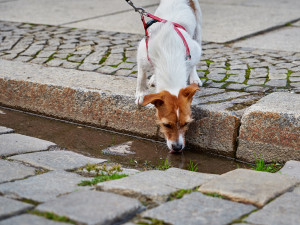What Is Canine Distemper?
Learn the signs and symptoms of this dangerous pathogen.

Share Article
Canine distemper is a highly contagious and potentially fatal disease that affects dogs, puppies and many species of wildlife. Caused by the Canine Distemper Virus (CDV), distemper targets multiple body systems — respiratory, gastrointestinal, and nervous — and has up to an 80 percent mortality rate. Even after recovery, this disease can still have lasting effects, making the canine distemper virus one of the most dangerous pathogens your dog can encounter.
How Canine Distemper Spreads
Canine distemper is transmitted between dogs via coughingopens in a new tab or sneezing, or by shared objects such as food and water bowls. Distemper can be passed by pregnant dogs to their puppies, and dogs who interact with infected wildlife are also at risk.

Get (totally free) deals for food, treats, accessories, tech, and way more pet parenting must-haves.
opens in a new tabAny dog can potentially contract canine distemper, but puppies under 12 months and unvaccinated dogs are at greatest risk. Dogs in crowded settings such as animal shelters, breeding operations, and pet stores are especially vulnerable because of sustained close contact and the challenges of maintaining proper hygiene.
Canine Distemper Signs and Symptoms
Not only can distemper be difficult to diagnose during early onset because signs and symptoms can be mild or absent, but it is often mistaken for other diseases with similar clinical signs. Veterinarians diagnose distemper by taking a history, evaluating clinical signs, and performing laboratory tests. Common signs and symptoms of distemper include:
Coughing
Sneezing
Discharge from eyes and nose
Fever
Rapid-onset diarrheaopens in a new tab or vomitingopens in a new tab
Since distemper also affects the nervous system, the signs and symptoms listed above may be accompanied by:
Circling
Muscle twitching
Head tilt
Nystagmus (rapid, uncontrolled eye movement)
Dogs can be infected with distemper for up to four weeks before they begin to exhibit sickness, so it’s vital that they are seen by a veterinarian immediately after any signs and symptoms manifest.
Treatment and Recovery
There is currently no cure for distemper. Treatment for canine distemper consists of hospitalization and supportive care. Multiple factors can affect the success of treatment and speed of recovery, including age, vaccination statusopens in a new tab, general health, and how quickly the dog’s immune system responds to the infection.
Treatments include:
Intravenous fluids and nutrients to combat dehydration and malnutrition
Antibiotics to prevent secondary bacterial infections
Medications to relieve vomiting/diarrhea
Sedatives to control seizures
Analgesics to alleviate pain
Steroids, if cerebral edema (swelling around the brain) is suspected
Even if a dog recovers from an acute canine distemper infection, the effects of the virus can cause varying levels of permanent neurological damage, as well as compromised tooth enamel and hardening of the nose and foot pads. In some cases, distemper’s neurological symptoms can be controlled by medications, but this depends on the severity of the symptoms and quality of life of the dog.
After clinical recovery, dogs may continue to shed the distemper virus for up to four months, so they should be kept away from unvaccinated puppies or other areas where dogs congregate. With follow-up testing, your veterinarian can determine when it’s safe to reintroduce recovered dogs into the general population.
Prevention
Vaccination and safe habits are the best defense against canine distemper. The distemper vaccine (DHLPP) should be given to puppies starting at six weeks of age, repeated every three to four weeks until the puppy is 16 weeks old, and then given once a year. Keep puppies away from areas where dogs congregate and separate them from other unvaccinated or potentially infected dogs until their vaccination course is complete.
Keeping dogs away from wildlife is also important, as distemper can be carried by raccoons, foxes, coyotes, skunks and other woodland animals.
The canine distemper virus is not particularly hardy outside the body and can’t persist in the environment for long periods, so cleaning protocols are relatively easy to maintain. Dilute bleach and most household disinfectants will kill the virus; a long post-sanitation waiting period is not typically required. In addition to cleaning, always remove exposed bedding, toys and food/water bowls.
Instances of canine distemper infections in domestic animals have been drastically lowered with the introduction of vaccines, but it still remains a regular cause of mortality among stray or unvaccinated populations.

Abbie Deleers, LVT
Abbie Deleers is a licensed vet tech and founder of the nonprofit organization Vet Techs Without Bordersopens in a new tab. She enjoys traveling with animal rescue groups, swimming with sharks, and outdoor activities with her husband and their Siberian Husky in the beautiful Pacific Northwest.
Related articles
![Dog drinking water from a puddle in the road]() opens in a new tab
opens in a new tabGiardia in Dogs: Signs, Symptoms and Treatment of This Parasite
If your dog drinks from puddles or splashes around in lakes, read this.
![Dog on leash running in a field without foxtails]() opens in a new tab
opens in a new tabWhy Foxtails Are So Dangerous for Your Dog
Late spring is prime time for these blades of grass that pose a serious risk to your pup.
![]() opens in a new tab
opens in a new tabScared Stiff: How to Spot Tetanus in Dogs
Yes, dogs can get tetanus too — and not just from rusty nails.
![Dog laying on couch in the sun]() opens in a new tab
opens in a new tabSeizures Are the Stuff of Dog-Parent Nightmares
What you need to know about seizures and dogs (and canine epilepsy) so you’re prepared and your pup is cared for.



